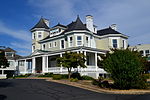Leesburg Historic District (Leesburg, Virginia)
Georgian architecture in VirginiaGreek Revival architecture in VirginiaHistoric American Buildings Survey in VirginiaHistoric districts in Loudoun County, VirginiaHistoric districts on the National Register of Historic Places in Virginia ... and 5 more
Leesburg, VirginiaLoudoun County, Virginia Registered Historic Place stubsNRHP infobox with nocatNational Register of Historic Places in Loudoun County, VirginiaNeoclassical architecture in Virginia

The Leesburg Historic District in Leesburg, Virginia is a historic district that includes Classical Revival, Greek Revival, and Georgian architecture and dates back to 1757. It was listed on the National Register of Historic Places in 1970 and its boundaries were increased in 2002.In 2004, the Victorian era Second Empire - Italianate influenced Carlheim Mansion and 16-acre (65,000 m2) grounds (aka "Paxton") were added as a non-contiguous part of the Leesburg Historic District. The property is held in private trust and became the home of the Margaret Paxton Memorial Learning and Resource Campus, which includes the Aurora School, in November 2009.
Excerpt from the Wikipedia article Leesburg Historic District (Leesburg, Virginia) (License: CC BY-SA 3.0, Authors, Images).Leesburg Historic District (Leesburg, Virginia)
West Market Street, Leesburg
Geographical coordinates (GPS) Address Nearby Places Show on map
Geographical coordinates (GPS)
| Latitude | Longitude |
|---|---|
| N 39.114722222222 ° | E -77.565833333333 ° |
Address
Town Hall Garage
West Market Street 17
20175 Leesburg
Virginia, United States
Open on Google Maps








